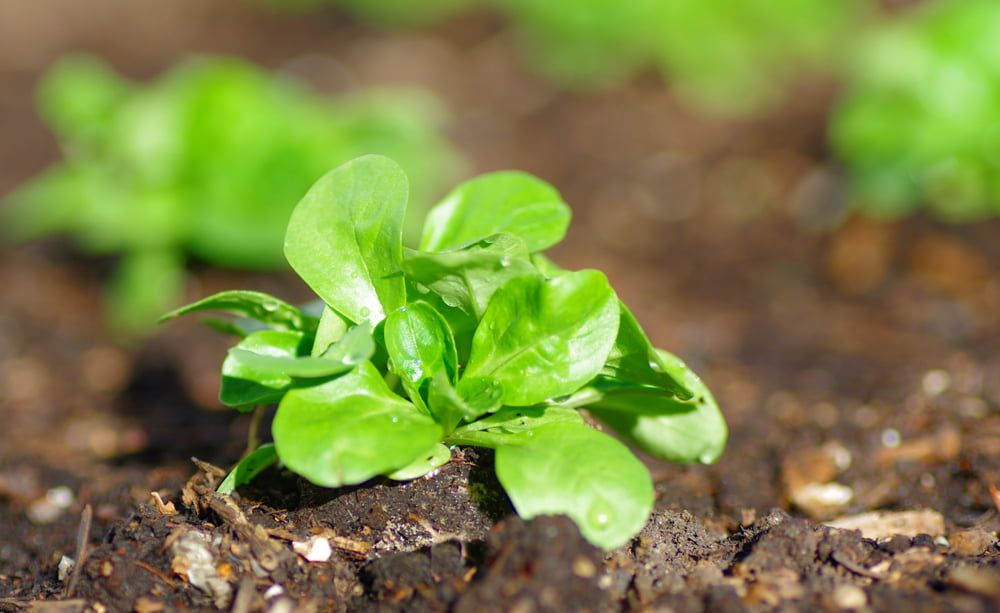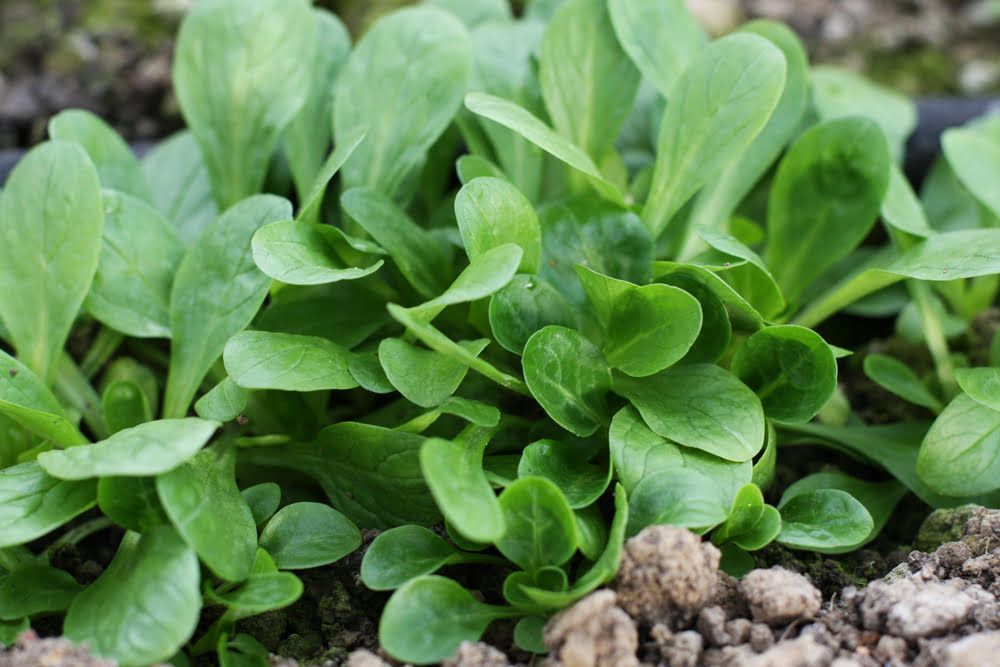
Also known as lamb’s lettuce, corn salad is a small, fast-growing annual plant that’s used as a salad green. While these dark green leaves don’t have the same crisp texture as lettuce, they’ve got a beautifully tender, melt-in-your-mouth quality, along with a nutty and slightly floral flavour, making this a plant a worthy addition to any vegetable garden.
Growing Corn Salad: A Quick Snapshot
When to Sow – Jul-Oct
When to Plant – Mar-May/Aug-Oct
When to Harvest – Oct-Jun
Average Yield per Plant – 50g
Spacing – 8-10cm
Depth – 1cm
How to Grow Corn Salad at Home
There aren’t many salad greens that do well over the winter, which is partly what makes corn salad so popular. While you can sow it in the spring, the plants struggle and quickly bolt in hot temperatures. Instead, sow your seeds towards the end of summer and you could be harvesting fresh greens throughout the winter.
Corn salad is an extremely hardy and resilient crop. In fact, some would consider it to be a weed because it can be very prolific once it gets going, especially if you’re able to provide it with the right growing conditions.
Growing Requirements for Corn Salad
Although corn salad does best in the sun, this only really applies to crops growing in the colder months. If you’re trying to grow this vegetable in the summer, you’ll need to give your plants a little shade, especially in the afternoons when the sun is at its strongest.
Corn salad isn’t fussy when it comes to soil. It will grow vigorously in just about anything, although fertile soil will give you leafier plants.
In terms of size, corn salad doesn’t need much room. It grows into a small rosette, with its leaves stretching out for just 15cm. Because of this, many gardeners choose to slot corn salad in between other crops, rather than dedicating an entire bed to it.
How to Grow Corn Salad from Seed
Corn salad is easy to grow from seed. You can either start them off inside (which can be useful if slugs are prevalent in your garden, since they’ll decimate young seedlings) or sow them directly outside, with successional sowing being the way to go for a steady harvest. That said, you’ll probably only need to sow these seeds once – allow a few plants to flower and they’ll happily self-seed around your garden.
How to Sow Corn Salad Seeds in Modules:
- Fill module trays with a multi-purpose compost. Choose large modules if possible – research shows that this helps to increase final yield
- Water well, making sure that none of the drainage holes are blocked
- Sow a couple of seeds into each module, about 1cm deep
- Water lightly again from above
- Place your trays somewhere cool, since heat will inhibit germination. Corn salad seeds germinate best in temperatures between 5-18°C
It takes between one to three weeks for corn salad seeds to germinate. Once they do, move your trays to an area that receives plenty of sunlight, and keep your seedlings moist. After a week or so, thin them out, leaving just one seeding per module.
How to Direct Sow Corn Salad Seeds:
- Remove any weeds from your growing area
- Create shallow furrows in the ground, just 1cm deep. Space each row 30cm apart
- Sow your seeds, aiming for about 1cm of space between each seed
- Cover your seeds over with soil and give them some water if the soil is dry
Once your seedlings germinate, thin out the excess seedlings, leaving 8-10cm between each plant.
How to Plant Corn Salad Outside
Once your corn salad has a couple of sets of true leaves, it can be planted outside. However, before you do so, spend about a week hardening your seedlings off – they’ll need time to adjust to outdoor elements before permanently moving out.
Weed your growing area, and then dig small holes, just slightly deeper and wider than the root balls of your seedlings. Space each hole 8-10cm apart. Gently remove your plants from their modules and place them into their new homes, covering the roots over with soil. Firm the soil down around each seedling and then water well.
How to Plant Corn Salad in a Greenhouse
Since corn salad prefers cooler temperatures and overwinters well, most gardeners grow it outdoors. However, those who live in colder regions may find it beneficial to plant some corn salad in a greenhouse – this will give you bigger and better harvests over the winter months.
To do this, follow the same planting methods as when planting corn salad outside. Alternatively, sow your seeds into a larger pot that you can keep them in for the duration of the plant’s lifecycle.
How to Care for Corn Salad
Corn salad requires very little care – as mentioned, many would say that this plant grows just like a weed! However, leave it to its own devices and your yields could suffer. If you want to ensure that your plants are able to regularly feed you over the colder months, make sure that you do the following:
Watering Corn Salad
While your corn salad seedlings are young, they’ll require plenty of water. However, once they start to mature, they won’t need quite so much. Give them some water whenever the top 3cm of soil feels dry.
Keep in mind that corn salad doesn’t have long roots, meaning that your plants won’t do well in drought-like conditions. That said, don’t overwater them either – this could lead to the development of diseases.
Feeding Corn Salad
Corn salad isn’t a heavy feeder – it’ll grow even in the poorest of soils. That said, nitrogen can definitely help to encourage thick, leafy growth. If you know that your soil is lacking, an application of a slow-release nitrogen-rich fertiliser soon after planting your seedlings out will give your plants a boost. Alternatively, mulch them with some quality compost or well-rotted animal manure.
Weeding Corn Salad
Weeds won’t do your corn salad plants any favours. Instead, they’ll use up precious nutrients in the soil, while dominating moisture and light, leaving your plants lacking. Since corn salad only grows to about 20cm tall, it doesn’t take long for weeds to smother out these low-growing plants.
This means that regular weeding around your corn salad plants will be needed, at least until winter hits and most of those weeds die back on their own. One way to cut back on the amount of weeding that you’ll need to do is by mulching your plants. This has the added benefit of providing some extra warmth and protection over the winter, which should help to extend your harvesting period.
How to Harvest Corn Salad
Corn salad is usually ready for harvesting about two to three months after sowing. You’ll know that the leaves are good to eat when they take on a dark green colour and a slight velvety feel.
If you only require a few leaves, simply snip off what you need. Alternatively, harvest an entire rosette by using a sharp knife to cut the plant a few centimetres above the ground. Leave the roots in and they’ll produce a second crop of leaves in a few week’s time.
How to Store Corn Salad
For short-term storage, place your unwashed corn salad leaves into a plastic bag and then store this in the fridge. They’ll be good to use for about two weeks.
Although corn salad can technically be frozen, the leaves lack flavour and texture once defrosted. It would be just like freezing regular lettuce, which isn’t very appealing. While there may not be any suitable long-term storage options for corn salad, this isn’t usually a big deal. Since the plant can be harvested almost year-round, long-term storage isn’t often needed.
How to Prepare & Cook Corn Salad
Since corn salad is a low-growing crop, its leaves often touch the ground. This means that they’ll likely be dirtier than some of the other salad greens you may be harvesting, so give them a good wash. However, don’t do this until just before you’re ready to use or serve the greens, because the leaves won’t hold up for long after being washed.
When it comes to using corn salad in the kitchen, salads are usually the go-to. This vegetable has a distinct yet delicately subtle taste, meaning that it combines beautifully with other, more pungent, leaves, such as rocket.
If you’re ready to get a little more creative with your corn salad harvest, here are a few ideas to try:
- Corn salad leaves with cooked beetroot and walnuts (a traditional French dish)
- Corn salad cream soup
- Lightly steamed with garlic
- Corn salad omelette
- Corn salad fishcakes
Common Corn Salad Problems
Although relatively trouble-free, there are a few issues that you should be aware of when growing corn salad:
- Slugs – if this common garden pest usually tries to ravage your vegetable garden, you can expect them to target your corn salad too. They’ll munch holes in the leaves and leave a slime trail behind. Fortunately, there are numerous slug deterrents out there to choose from. Beer traps work well, as does mulching your plants with sheep fleeces
- Aphids – these bugs will suck the sap from your plants, inhibiting and distorting growth. You’ll be able to spot them clustering together on the undersides of your corn salad leaves. In small numbers, a strong jet from your garden hose should knock them off. However, you may need to turn to an organic aphid spray if you notice them in large quantities
- Powdery mildew – corn salad grown during the warmer months of the year commonly succumbs to powdery mildew. This disease, which will cause white powdery spots to form on leaves, thrives in warm and overcrowded conditions. Give future plantings more space and ventilation, and wait for cooler temperatures before growing corn salad again
Popular Corn Salad Varieties to Grow
Some varieties of corn salad do better in the spring and autumn, while others need the cold temperatures of winter. Here are a few of the most popular varieties to choose from:
- Verte de Cambrai – many would say that this is restaurant-quality corn salad. It’s cold-tolerant and copes with some warmth too, making this a variety that can be grown almost year-round
- D’Olanda a Seme Grosso – with lighter green leaves than other varieties, some gardeners don’t find this one to be as visually attractive. However, the leaves are loved for their large size, which gives them a much meatier texture
- D’Olanda Sel. Ortolani – this hardy variety boasts extremely tender leaves that are resistant to very cold temperatures
- Favor – these dark green leaves have a more upright growing habit, which saves them from getting quite so dirty
- Baron – one of the fastest-growing varieties – you’ll be harvesting your first leaves just 40 days after sowing the seeds
Conclusion
Considered to be a historical crop, corn salad was once a staple in vegetable gardens around the world. It’s not quite as commonly grown today, and that’s a shame. There aren’t many salad greens that will continue to provide throughout the winter, which is what makes corn salad so special. It’s also easy to care for and tastes absolutely delicious, making it a win-win for anyone trying to grow more of their own food.







